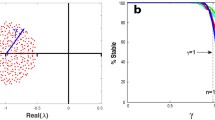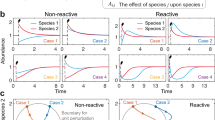Abstract
We have numerically examined more than one million Large Complex Systems (LCS) of interacting variables (interpretable as interacting populations) governed by Generalized Lotka-Volterra Equations (GLV), with self-regulation term. The scope was to have some insight on the stability-complexity relationship.
We considered systems of prey-predator type, and we gave appropriate rules for constructing the model systems, rules that specify the behaviour of model systems in order to put them near the biological reality.
The results show, among other things, a strict correlation between the stability and the prey-predator ratio (which, in our model, uniquely determines the connectedness of the system).
Similar content being viewed by others
Literature
Gardner, M. R. and W. R. Ashby. 1970. “Connectedness of Large Dynamical (Cybernetic) Systems: Critical Values for Stability.”Nature,228, 784.
Gilpin, M. E. 1975. “Stability of Feasible Predator-Prey Systems.”Nature,254, 137–139.
Goel, N. S., S. C. Maitra and E. W. Montroll, 1971. “On the Volterra and other Non-Linear Models of Interacting Populations.”Rev. Mod. Phys.,43, 231–276.
Granero-Porati, M. I., A. Porati and A. Vecli. 1978. “Analytical Conditions for the Conservative Form of the Ecological Equations.”Bull. Math. Biol.,40, 257–264.
—, R. Kron-Morelli and A. Porati. 1981. “Stability of Model Systems Describing Prey-Predator Communities.” InQuantitative Population Dynamics Vol. 13. Eds. D. G. Chapman, V. Gallucci and F. M. Williams. Fairland, MD: International Cooperative Publ.
Harary, F. 1967. “Graphical Enumeration Problems.” InGraph Theory and Theoretical Physics, New York: Academic Press.
— 1974. “A Survey of Generalized Ramsey Theory.” InLecture Notes in Mathematics, Vol. 406, pp. 10–17, Berlin: Springer.
May, M. R. 1972. “Will a Large Complex System be Stable?”,Nature,238, 413–414.
Roberts, A. 1974. “The Stability of Feasible Random Ecosystem.”Nature,251, 607–608.
Siljak, D. D. 1974. “Connective Stability of Complex Ecosystems.”Nature,249, 280.
— 1975. “When is a Complex-Ecosystem Stable?”Math. Biosc.,25, 25–50.
— 1978. “Large-Scale Dynamic Systems,” New York: North Holland.
Tregonning, K. and A. Roberts 1978. “Ecosystem-Like Behaviour of a Random-Interaction Model—I.”Bull. Math. Biol.,40, 513–524.
Author information
Authors and Affiliations
Rights and permissions
About this article
Cite this article
Granero-Porati, M.I., Kron-Morelli, R. & Porati, A. Random ecological systems with structure: Stability-complexity relationship. Bltn Mathcal Biology 44, 103–117 (1982). https://doi.org/10.1007/BF02459422
Received:
Revised:
Issue Date:
DOI: https://doi.org/10.1007/BF02459422




